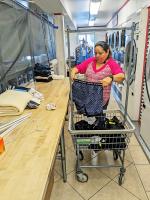OAKBROOK TERRACE, Ill. — Two store owners who run successful wash/dry/fold (WDF) businesses within their laundromats offered cautionary tales along with tips for expanding beyond self-serve during a recent Coin Laundry Association webinar.
In “Wash/Dry/Fold Operations: From A to Z,” California’s Ross Dodds, who owns several Luxe Laundries in the Los Angeles area, and Washington state’s Colleen Unema, who owns Brio Laundry near the Canada border, described their strategies for finding customers, staffing, tracking, and other criteria that goes into offering WDF.
WEIGHING WDF WITH EVERYTHING ELSE
Dodds’ entry into laundry services was not an easy one, as the first store he purchased in 2014 burned down five days later in a fire unrelated to the business. Undaunted, he went about rebuilding the first store while purchasing a second and opened both in January 2017. His husband joined the laundry business full-time in 2021.
There are currently eight Luxe Laundries open 6 a.m. to midnight daily (two offer fluff-and-fold services), plus a facility dedicated to pickup and delivery. Luxe employs roughly 40 people across all its locations. Combined, his operation processes 5,000 to 7,000 pounds of walk-in WDF business per month and 80,000 pounds of commercial/residential WDF delivery per month.
Unema opened Brio Laundry, a 3,000-square-foot self-service laundromat with WDF service available, in Bellingham, Washington, in 2013. It’s consistently had eight employees, either full- or part-time, since opening. The store is open 6 a.m. to 11 p.m. seven days a week.
In 2019, she rebuilt and opened a plant for commercial laundry and wet cleaning. Each segment has a couple full-timers and a handful of part-timers, she says.
There is a dedicated box truck with a full-time driver for commercial laundry making rounds six days a week, and a minivan and part-time driver covering residential WDF routes five mornings a week. The latter service was added after the COVID pandemic began, Unema adds.
Brio processes about 4,000 pounds of WDF work a month.
Dodds’s business offers standard 24-hour turnaround on drop-off WDF, and same-day pickup for a premium charge. Operations are fully staffed daily using three shifts (shifts sometimes overlap an hour or two).
WDF customer clothes are tagged by bag (a disposable wristband that is difficult to remove without using scissors identifies each soiled-laundry bag), an order ticket is generated, and staff uses an erasable marker to write the customer’s name right on the machine(s) being used to wash/dry their clothes. Once clean, the clothes are folded and bagged in plastic and stored in a reusable tote awaiting pickup. Incoming and outgoing orders are weighed to help track possible losses.
Pickup and delivery across four zones in a large service area adds a few more steps, says Dodds. Two drivers handle commercial accounts each morning seven days a week, and two more drivers address residential accounts each afternoon or evening seven days a week. Route operations are managing using computer software, and drivers use iPhones for routing. Drivers take photos at each stop to document successful pickup/delivery or failure for some reason (clothes not left where customer said, etc.).
Dodds estimates his operation’s WDF customers are 70% women, 30% men. An average customer is in their early 30s to early 40s and active.
“In Los Angeles, everybody lives in apartments or condos,” he says. “New buildings tend to have washers and dryers available but that’s not something the average customer is going to bother with.”
Where Dodds’s operation is serving a large metropolitan area, Unema’s is located in a coastal city surrounded by agriculture, mountains and the Pacific Ocean. The area about 100 miles north of Seattle is home to roughly 200,000 people.
WDF customer clothes are weighed and the customer pre-pays based on that soiled weight. A ticket is issued that states the number of pounds, the price, and when the customer should return to pick up their order. At the time of payment, customers are asked if they’d like their card stored on file with Brio to ease WDF ordering in the future.
Orders receive unique numbers and are placed in bins to await processing. All bags are tracked via software. Anyone working on an order must input their ID because work continues across shifts. Once an order is processed, it’s wrapped in paper and a thank-you note is added. Packages are staged behind the counter for customer pickup.
“There really is not a demographic change between our self-serve customer and our pickup and delivery, or wash/dry/fold, customer,” Unema says. “I’ll bet at least half of my regular customers in the store have tried wash/dry/fold and will use it by circumstances.”
Maybe an elderly parent is recovering from knee surgery, or a family is going out of town on a trip and they want everyone’s clothes cleaned before leaving.
“We kind of joke that if they carry a Visa (card), they’re our customer,” Unema says. “That’s really true. I had the whole study done of who [our customers] are and it’s basically a Visa. That’s my customer. That demographic, homeowners that have their own laundry, it’s convenience, convenience, convenience.”
Check back Thursday for the conclusion!
Have a question or comment? E-mail our editor Bruce Beggs at [email protected].



















